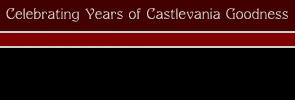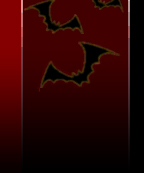|
Castlevania: Harmony of Dissonance (2002)

Harmony of Dissonance begins with Juste Belmont and his buddy Maxim Kishine entering the castle, where they split up to find their kidnapped friend Lydie. From there, the tale gets more bizarre - Maxim begins to act strangely, and Juste begins to suspect that something is, obviously, wrong.
The first thing you'll notice about the gameplay is that it's fast. Juste trots along at a quick pace, and the shoulder buttons let him dash forward and backward with the greatest of ease, making both exploration and combat very quick.
You can technically save any time, but when you restart the game, you'll be back at the last save room. Much like Symphony, there are several merchants to be discovered that will sell you potions and other vaguely interesting stuff. There are two castles to explore, though they are pretty much the same, just with minor differences and altered graphics and enemies. However, you are introduced to this second castle near the beginning of the game, so exploring both castles are the same time becomes a rather confusing task later on. As an additional oddity, there is a room that Juste can collect items for to decorate.
Like Circle of the Moon, there are various bits of clothing and armor to increase your defense, and stones to attach to your whip to alter its elemental affinity. There are also the usual artifacts that let you slide, double jump, see damage statistics - same old, same old. The new weapon system is called "Spell Fusion" - you search down spell books (hidden throughout the castle, not in enemies like the cards from Circle of the Moon.) When you use any of the six special weapons (Dagger, Cross, Bible, Super Fist, Axe or Holy Water) it will create a special effects. The ice book with the dagger will through an assortment of daggers that home in on the closest enemy. The ice book with a cross will create a ball of ice that follows Juste for a short period of time (like a familiar) and shoots projectiles. While there's plenty of neat attacks, it lacks the depth of the DSS card system.
One of the biggest problems with Circle of the Moon were its graphics - they weren't bad, but not only were they horribly dark, but their repetetiveness made many of the areas stale and forgettable. Harmony of Dissonance has taken a tremendous leap in the right direction - the graphics are not only brighter, but more varied. As a whole, it's obviously not quite the same as Symphony of the Night, but it's still damn good. Some of the larger, multi-segemented enemies (like Orlox from Symphony) look amazing.
Unfortunately, for the Gameboy Advance to process these types of graphics, the sound had to take a hit. The sound quality is just barely above that of an NES - something that classic gamers everywhere will be perfectly OK with, while everyone else will weep with displeasure. Despite the sound quality, there are at least a few tunes that are decent, if not up to the level of Circle of the Moon. On the bright side, the sound effects are very well done, with plenty of whip snaps, screams and yells.
The game succeeds very well in emulating Symphony of the Night - unfortunately, that's also one of its biggest failings. There's very little new here, nothing we haven't seen done (and in some cases, done better) in other Castlevania games. The bosses are either rehashes or are just lame, the castle areas are mostly the same places we've seen before, and there's very few new challenges brought to the table.
The castle design is something that's caused a bit of controversy, as the overall design is much more loose than before. It makes the castle feel even more like a maze than other Castlevania games of this type, and given that there's very little in the way of secrets (other than the useless room decorating subquest), it can get a bit frustrating. The later stages of the game, which require exploring two nearly identical castles, is also rather tedious.
Much like Symphony, the game is also fairly easy, and a bit on the short side (full completion of the game takes about 4-5 hours.) However, beating the game unlocks a boss rush mode, and the ability to play as Maxim (similar to Richter's game in SotN, there's no plot in his game.) As an additional service to fans, Konami put Simon Belmont in the game, playable in the Boss Rush mode. Once you've beaten the game, restart the system. At the Konami screen, put in the Konami code (Up, Up, Down, Down, Left, Right, Left, Right, B, A). . Don't hit start. If this is done correctly, the title screen will go back to its original color (blue). When you start Boss Rush, you play as Simon, complete with his NES sprite and stiff controls! Despite the lack of maneuverability, he's more powerful than Juste, and also has the cool Vampire Killer music playing in the background.
Despite its lack of originality and lack of hidden stuff, Harmony of Dissonance is still yet another top notch Castlevania game.
Harmony of Dissonance Artwork

Back to Top
Castlevania Games - Castlevania: Harmony of Dissonance
|
|
|



